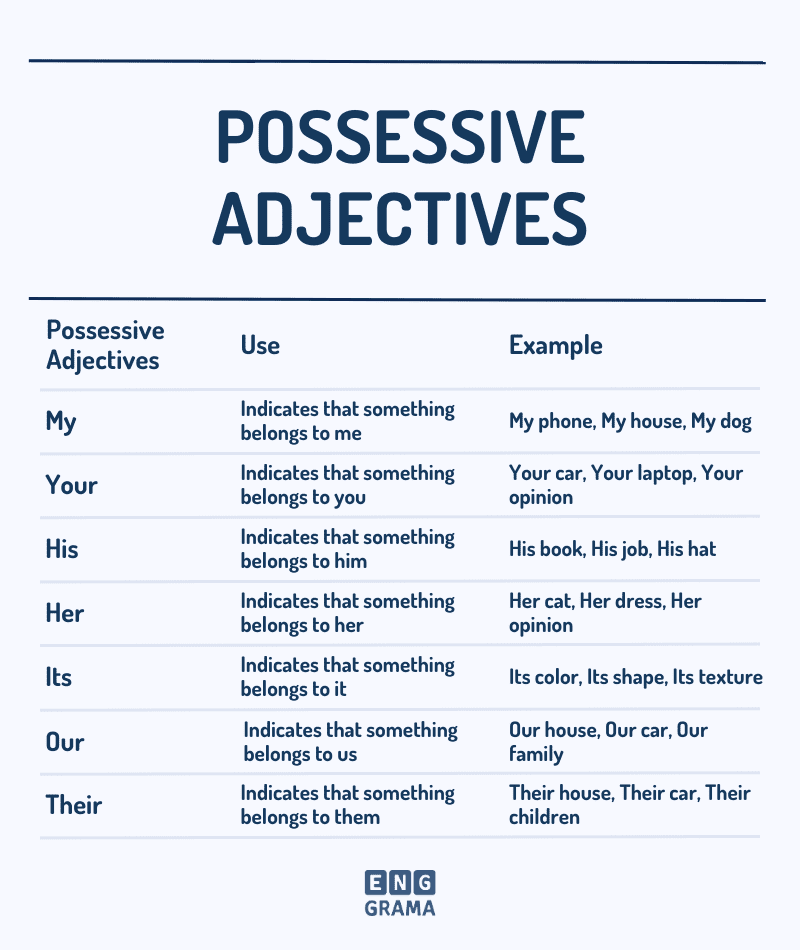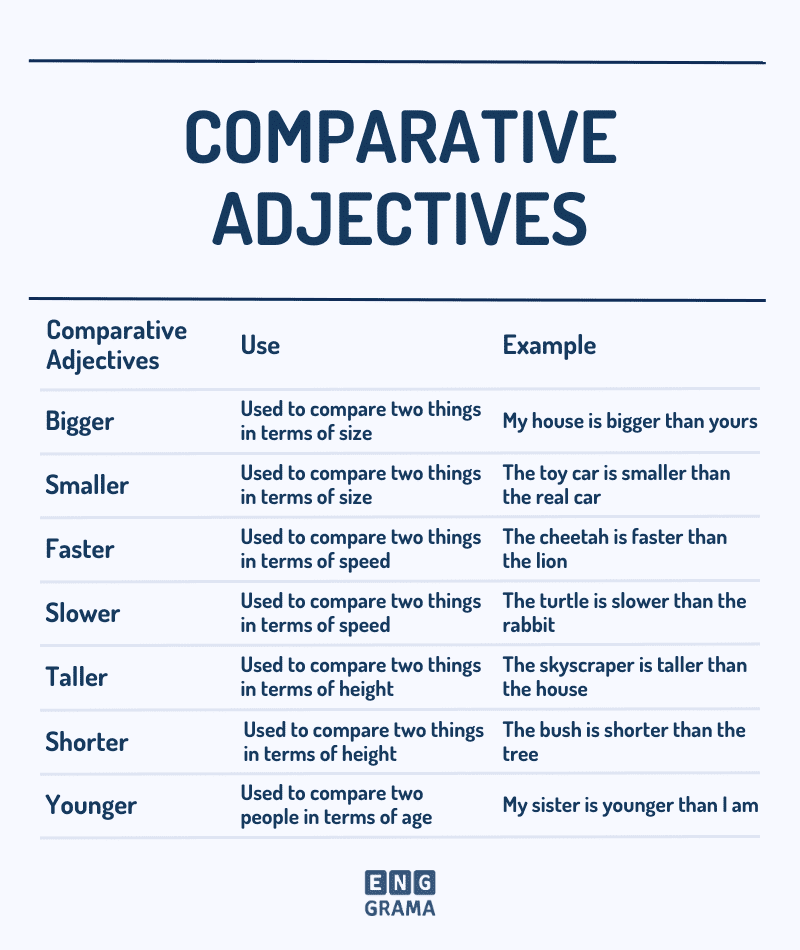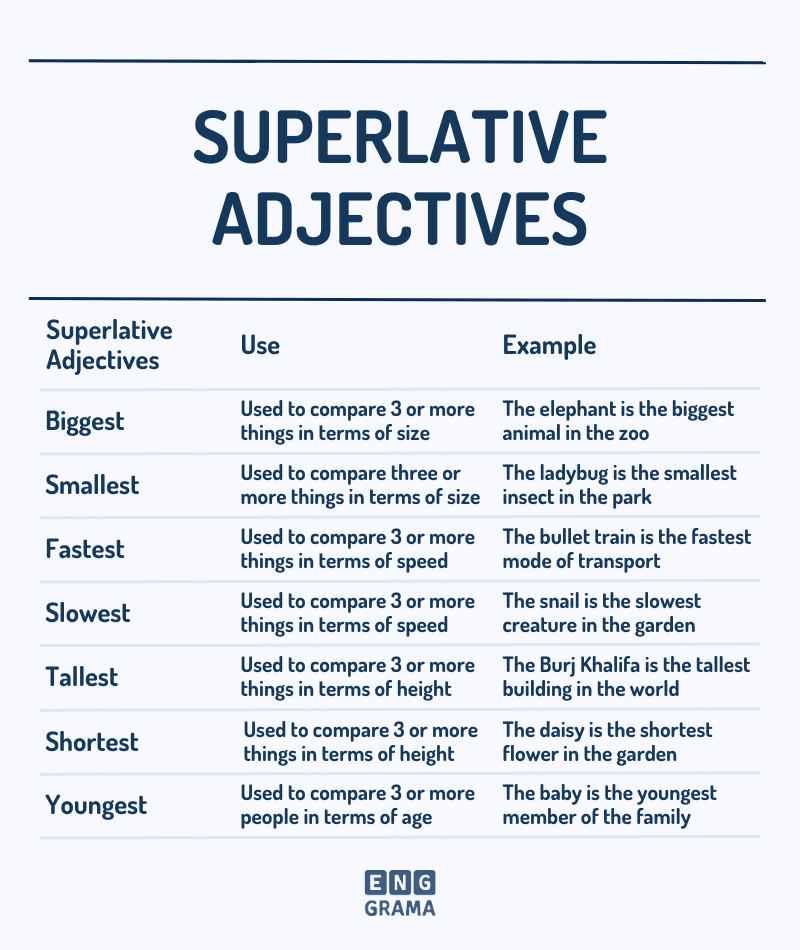HomeAdjectives
Adjectives
Adjectives
Mixed Adjectives
Test Your Adjective Knowledge with Our Fun and Engaging Adjectives Quiz.
What Is Adjective? | Different Types of Adjective | Examples & Notes
Adjectives are words that describe or modify nouns and pronouns. They help us add more information to our language, like how something looks, feels, or behaves.
For example, we might say “the big, “red ball” or “the happy dog”. Adjectives can come before or after the noun, and they can also be used to describe someone’s feelings or personality. Just be careful not to use too many adjectives or use them incorrectly, as it can make your writing sound strange or confusing
In a more understandable way:
Adjectives can be used to describe a noun or pronoun’s appearance, size, color, shape, texture, or other physical characteristics.
Adjectives can also describe a noun or pronoun’s personality, emotions, or attitudes.
Adjectives are often placed before the noun or pronoun they modify, but they can also come after the noun or be used as predicate adjectives after a linking verb.
Be careful not to overuse adjectives or use them inappropriately. Too many adjectives can make your writing seem overly flowery or verbose, while using adjectives that don’t quite fit the noun or pronoun can make your writing confusing or misleading.
Descriptive adjectives
Descriptive adjectives are used to describe the qualities or characteristics of a noun or pronoun. They add detail and depth to a sentence and help paint a clearer picture of what is being described..
Here are some examples of descriptive adjectives and how they can be used to add to a sentence:
Many – “There were so many dogs at the park, I couldn’t count them all.”
Few – “Unfortunately, very few cookies were left in the jar.”
Several – “I’ve been to that restaurant several times, and the food is always delicious.”
All – “I ate all the pizza and now I’m stuffed.”
Half – “After eating half a box of donuts, I was in a sugar coma.”
Double – “The company saw double the profits this quarter compared to last year.”
Single – “I was the only single person at the wedding, surrounded by couples.”
Plenty – “Don’t worry about running out of candy, there’s plenty for everyone.”
Empty – “The fridge was completely empty, I had to order takeout.”
Note:
For writers and presenters to create rich and engaging descriptions that engage their audience, descriptive adjectives are an important element.
Quantitative adjectives
Indicate the quantity or number of the noun or pronoun they are describing. They can be used to express how many or how much of something there is.
Below we have mentioned some examples of quantitative adjectives:
Many – “There were so many dogs at the park, I couldn’t count them all.
Few – “Unfortunately, very few cookies were left in the jar.”
Several – “I’ve been to that restaurant several times, and the food is always delicious.”
All – “I ate all the pizza and now I’m stuffed.”
Half – “After eating half a box of donuts, I was in a sugar coma.”
Double – “The company saw double the profits this quarter compared to last year.”
Single – “I was the only single person at the wedding, surrounded by couples.”
Plenty – “Don’t worry about running out of candy, there’s plenty for everyone.”
Empty – “The fridge was completely empty, I had to order takeout.”
Demonstrative adjectives
Demonstrative adjectives are words that indicate which noun is being referred to. They come before the noun and can either be singular or plural.
In English, there are four demonstrative adjectives: “this”, “that”, “these” and “those”.
To remember which demonstrative adjective to use, think of “this” and “these” as being close to you, while “that” and “those” are far away.
Here are some fun examples to help you remember:
“This” is for things close to you, like a hot cup of cocoa on a winter day.
“That” is for things farther away, like a rainbow in the sky.
“That” is for things farther away, like a rainbow in the sky.
“These” are for things close by, like the pair of socks on your feet.
“These” are for things close by, like the pair of socks on your feet.
“Those” are for things far away, like the stars in the night sky.
Another way to remember is to use the acronym “DTT” which stands for “Distance”, “Time”, “Thing”.
“This” is used to indicate something close in distance like “This book on the shelf”
“That” is used for something far away like “That building across the street”.
“These” are used for multiple things close by like “These cookies in the jar”.
“Those” are used for multiple things that are far away like “Those mountains in the distance”
In conclusion,
Demonstrative adjectives are useful tools for indicating which noun is being referred to. Remember to use “this” and “these” for things close to you, and “that” and “those” for things farther away. With these fun examples, you’ll be sure to remember them!
Possessive adjectives
Possessive adjectives are words that indicate ownership or possession.
They come before the noun and describe who the noun belongs to. In English, there are seven possessive adjectives: “my”, “your”, “his”, “her”, “its”, “our” and “their”.
Here are some examples to help you remember:
“My” is for things that belong to you, like your favorite pair of shoes.
“Your” is for things that belong to someone else, like your best friend’s car.
“His” is for things that belong to a male, like his lucky baseball cap.
“Her” is for things that belong to a female, like her fancy earrings.
“Its” is for things that belong to an object or animal, like a dog wagging its tail.
“Our” is for things that belong to a group of people, like our family vacation.
“Their” is for things that belong to multiple people, like their new house.
Another way to remember is to think of the phrase “POOP” which stands for “Person”, “Object”, “Ownership”, “Possessive”.
In conclusion,
Interrogative adjectives
Interrogative adjectives are words that are used to ask questions about a noun or a group of nouns. They come before the noun and describe the noun being asked about. In English, there are two interrogative adjectives: “which” and “what”.
Here are some examples to help you remember:
“Which” is used when there are multiple options to choose from, like “Which flavor of ice cream do you want?”
“What” is used when you’re asking for more general information, like “What time is it?”
Another way to remember is to think of a funny question using the word “which” or “what”.
“Which came first, the chicken or the egg?”
“What do you get when you cross a snowman and a shark? Frostbite!”
Note:
Using interrogative adjectives is a fun and easy way to ask questions about nouns. Remember to use “which” when choosing from multiple options and “what” when asking for more general information. With these examples, you’ll be sure to remember them!
Indefinite adjectives
Indefinite adjectives are words that describe nouns in a non-specific or vague way. They indicate that the noun is not definite or specific, and they can be used to indicate quantity, identity, or quality.
Some common examples of indefinite adjectives include “some”, “any”, “many”, “few”, “several”, and “all”.
Below we have mentioned some of the examples of Indefinite adjectives:
“Some” can be used to refer to an unspecified amount, like “I’d like some ice cream, please.”
“Any” can be used to refer to any amount, like “Do you have any books to recommend?”
“Many” can be used to refer to a large quantity, like “Many people enjoy hiking in the mountains.”
“Few” can be used to refer to a small quantity, like “Few people can solve this puzzle.”
“All” can be used to refer to the entirety of something, like “All dogs go to heaven.”
“Several” can be used to refer to more than a few, but not a lot, like “There are several flavors of tea to choose from.”
In conclusion,
Indefinite adjectives are useful tools for describing nouns in a non-specific or vague way. Remember to use “some,” “any,” “many,” “few,” “several,” and “all” to indicate quantity, identity, or quality. With these fun examples, you’ll be sure to remember them!
Distributive adjectives
Distributive adjectives are a type of adjective that describe how something is divided or shared among members of a group. They are used to refer to individual members of a group or to indicate that each member is considered separately.
In simpler terms, distributive adjectives are used when you want to talk about each individual thing in a group, rather than talking about the group as a whole.
Some common examples of distributive adjectives in English include “each”, “every”, “either” and “neither”. Here’s how to use each of them:
“Each” is used to describe every individual thing in a group separately. For example, “Each person at the party got a slice of cake.”
“Every” is used to describe a group of things as a whole, but with emphasis on the individual things within it. For example, “Every student in the class has a unique learning style.”
“Either” is used when you have two choices and you’re referring to one or the other. For example, “You can have either the chocolate cake or the vanilla cake for dessert.”
“Neither” is used when you have two choices and you’re referring to none of them. For example, “Neither movie playing tonight interests me.
In summary,
Distributive adjectives are a type of adjective that is used to describe how something is divided or shared among members of a group. They are used when you want to talk about each individual thing in a group separately. Examples of distributive adjectives include “each,” “every,” “either,” and “neither.”
Comparative adjectives
Comparative adjectives are a type of adjective that are used to compare two things. They indicate which of the two things has more or less of a particular quality. In English, comparative adjectives usually end in “-er” (e.g. “bigger,” “faster”) or are preceded by “more” (e.g. “more beautiful,” “more intelligent”).
In English, comparative adjectives usually end in “-er” (e.g. “bigger,” “faster”) or are preceded by “more” (e.g. “more beautiful,” “more intelligent”).
To use a comparative adjective, you need to have two things to compare. You can use the adjective to describe how one thing is compared to the other.
To use a comparative adjective, you need to have two things to compare. You can use the adjective to describe how one thing is compared to the other.
Below we have mentioned some of the examples of Indefinite adjectives:
“Some” can be used to refer to an unspecified amount, like “I’d like some ice cream, please.”
“Any” can be used to refer to any amount, like “Do you have any books to recommend?”
“Many” can be used to refer to a large quantity, like “Many people enjoy hiking in the mountains.”
For example:
“My car is faster than your car.”
“Susan is more intelligent than John.”
Comparative adjectives are also useful when you want to emphasize that one thing has more of a particular quality than another
For example:
“The apple pie is sweeter than the blueberry pie.”
“The movie was more entertaining than I expected.”
One thing to keep in mind when using comparative adjectives is that they don’t always follow the “-er” or “more” pattern. Some adjectives have irregular comparative forms.
For example:
“good” becomes “better” and “bad” becomes “worse”.
In summary,
Comparative adjectives are a type of adjective that are used to compare two things. They indicate which of the two things has more or less of a particular quality. Comparative adjectives usually end in “-er” or are preceded by “more.” They are useful when you want to emphasize that one thing has more of a particular quality than another.
Superlative adjectives
Superlative adjectives are a type of adjective that are used to compare three or more things. They indicate which of the things has the most or the least of a particular quality.
In English, superlative adjectives usually end in “-est” (e.g. “biggest”, “fastest”) or are preceded by “most” (e.g. “most beautiful”, “most intelligent”).
To use a superlative adjective, you need to have three or more things to compare. You can use the adjective to describe which of the things has the most or the least of a particular quality.
For example:
“My dog is the cutest of all the dogs in the park.”
“This is the most delicious pizza I’ve ever had.”
Superlative adjectives are useful when you want to emphasize that one thing has the most of a particular quality or the least of a particular quality.
For example:
“Mount Everest is the highest mountain in the world.”
“Mount Everest is the highest mountain in the world.”
“That was the most boring movie I’ve ever seen.”
One thing to keep in mind when using superlative adjectives is that they don’t always follow the “-est” or “most” pattern. Some adjectives have irregular superlative forms. For example, “good” becomes “best” and “bad” becomes “worst”.
Superlative adjectives are also sometimes used with the word “the” to make the comparison explicit.
For example:
“The elephant is the largest land animal.”
“This is the most beautiful sunset I’ve ever seen.”
Proper adjectives
It is a type of adjective that is derived from proper nouns. Proper nouns are specific names for people, places, and things, and proper adjectives are adjectives that are derived from these proper nouns.
For example:
“French” is a proper adjective that is derived from the proper noun “France.”
Proper adjectives are usually capitalized because they are derived from proper nouns. They are often used to describe things that are associated with the proper noun from which they are derived.
For example:
“I love Italian food.”
“We saw a Broadway show in New York City.”
“The Chinese New Year celebrations were amazing.”
Proper adjectives can be used to describe all sorts of things, from food and drink to cultural traditions to geographic locations. They are a useful way to be more specific and precise when describing something.
One thing to keep in mind when using proper adjectives is that they are not always the only adjective you will need. Sometimes, you will need other adjectives to describe the thing you are talking about in more detail.
(FAQs) About Adjectives
To Practice and Improve Your Skills,











